Another shark – 1/48 Hasegawa P-40K
The P-40K was a development from the P-40E, which continued use of the Allison V-1710 engine and appeared simultaneously with the P-40F, which used the Packard Merlin. The P-40K used the more powerful Allison V-1710-73 (F4R) engine, with developed 1,325 h.p., over the Allison V-1710-39 (F4R) with its 1,150 h.p. of the P-40E. The P-40E-5 had used a fin extension in an attempt to cure the directional stability problem associated with the short-coupled design inherited from the P-36. The P-40K used this fin extension with a vertical fin and rudder of increased chord, known as the “Round-Tail” P-40 due to the change. The P-40K-1 and P-40K-5 were produced with the short fuselage and “round tail,” before production moved on to the P-40K-10, which featured the lengthened fuselage that solved the directional stability problem more effectively.
The 51st Fighter Group was established at Hamilton Field, California, in January 1942, consisting of the 16th, 25th and 26th Fighter Squadrons, under the command of Major Homer L. “Tex” Sanders. Following the attack on Pearl Harbor, the 51st was one of three fighter groups - the others being the 49th and 35th Fighter Groups - alerted for transfer to the Pacific in January 1942. Originally, the groups would reinforce the Philippines, but after they left San Francisco aboard the S.S. “President Coolidge,” their destination was changed to Australia, where they arrived at Melbourne on February 1, 1942. With the war going badly, the 51st was alerted for a movement into the combat zone, leaving Fremantle on February 23, 1942, aboard the transport USS “Holbrook” in company with the airplane tender USS “Langley” and freighter “Sea Witch,” carrying their P-40Es to Java. On February 27, 1942, the “Langley” was sunk with all aircraft, and the “Sea Witch” was badly damaged. The “Holbrook” was ordered to Colombo, Ceylon, then to Karachi. On arrival on March 12, the 51st was without aircraft.
On April 22, 1942, P-40-equipped units on the U.S. East Coast were stripped of pilots and aircraft, 68 which were put aboard the carrier USS “Ranger” in New York harbor. Half were new P-40K-1s. Among the pilots was 1st Lt. Edward Nollmeyer, late of the 54th Fighter Group. The “Ranger” headed for Africa. On May 10, 1942, the P-40s were launched at sea, headed for Accra, Guinea. Within days they began an odyssey across Africa in 6-plane groups, accompanied by B-25s for navigation, first to Lagos, Nigeria, then Lake Chad, across to Sudan, up to Cairo, on to Jerusalem, across the forbidding desert to Baghdad, then across the Strait of Hormuz to Karachi. 62 made the entire trip, with six putting down in Africa when they became lost, though all 68 pilots eventually made it to Karachi.
In Karachi, 32 pilots and aircraft were assigned to the new 23rd Fighter Group, the replacement for the American Volunteer Group, and sent to Kunming for the China Air Task Force. The others, including Nollmeyer, joined the 51st, which sent the 16th FS to Kunming with the 23rd Fighter Group. The following week three experienced pilots were sent to Assam, to fly recon over Burma.
In October, the 51st became responsble for air defense of the southern terminus of “the Hump” in Dinjan, India. On October 26, 1942, 90 “Sally” bombers and “Oscar” fighters appeared without prior warning. Colonel Sanders, the group CO, and his wingman had taken off on a patrol and spotted the Japanese, shooting down two Oscars, while the Japanese destroyed 3 P-40s, two P-43s and damaged 13 other P-40s. 24 hours later, the 64th Sentai sent Oscars to strafe the base. Among the Americans who met the attackers was 1st Lt. Nollmeyer, who pursued one of the Ki.43s and exploded it for his first victory.
The Japanese left the base alone after this, but the 25th and 26th Squadrons continued to patrol the towering Himalayas, and branched out with strafing attacks in Burma by the end of the year. The Japanese began an offensive into Assam in February 1943, which brought the 51st into combat again, with a big battle on February 25, 1943, against 27 attacking Sallys with an escort of 21 Oscars, which became the unit's best day in Assam. Nollmeyer scored his second Oscar, one of 14 victories claimed that day, with 13 probables. A final victory in April 1943 over a Dinah was the unit's last score in India.
Over the summer of 1943, as other pilots completed their tours, Nollmeyer was given command of the 25th Fighter Squadron, and then promoted to Major in September 1943. In October 1943, after the monsoon, the 51st was transferred to the 14th Air Force in China, where they would defend the northern end of “the Hump” in Kweilin, in southern Yunnan Province. Fighting got heavy in December 1943, with the Japanese offensive against Changteh. In the raging air battles around this offensive in December, Nollmeyer scored one Ki.43 on December 18 and two Oscars on December 23, to become the first ace of the 25th FS.
The kit is the 1/48 Hasegawa P-40E with one of the resin tails from Alan Griffiths of AMtech gave me and the AMtech (Three Guys Replicas) decals..

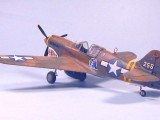
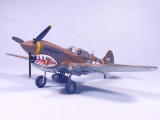
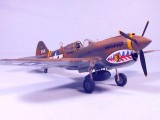
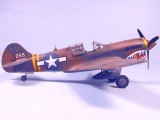

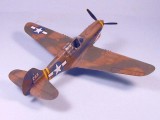
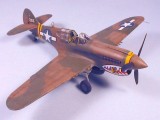

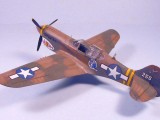
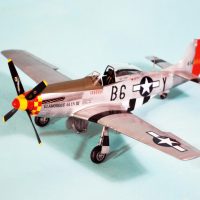
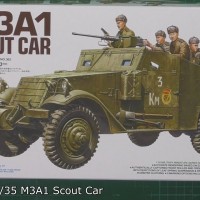
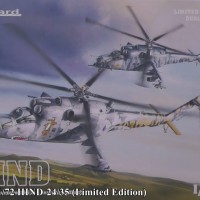
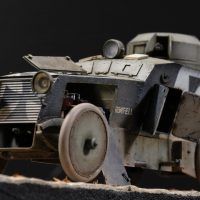
Great model and great history Tom. You are the man!
I always enjoy your very informative and interesting posts.
Gary
Tom, thanks for the story.
Building models was my way into education (inasmuch as a kid with Aspergers - which they didn't know about then - would have to get self-educated in spite of the system). What did that airplane do? What was that war about? How did that war happen? And 25 years later there were a Bachelors in Interdisciplinary Social Sciences and a Master's in History in my resume (despite my parents being told when I was 10 that I was "uneducable due to non-cooperation"). Thank goodness for the Denver Public Library main branch and its stacks, and a10-book adult card (and that librarians back. then weren't policing "age appropriate material", so long as you were quiet).